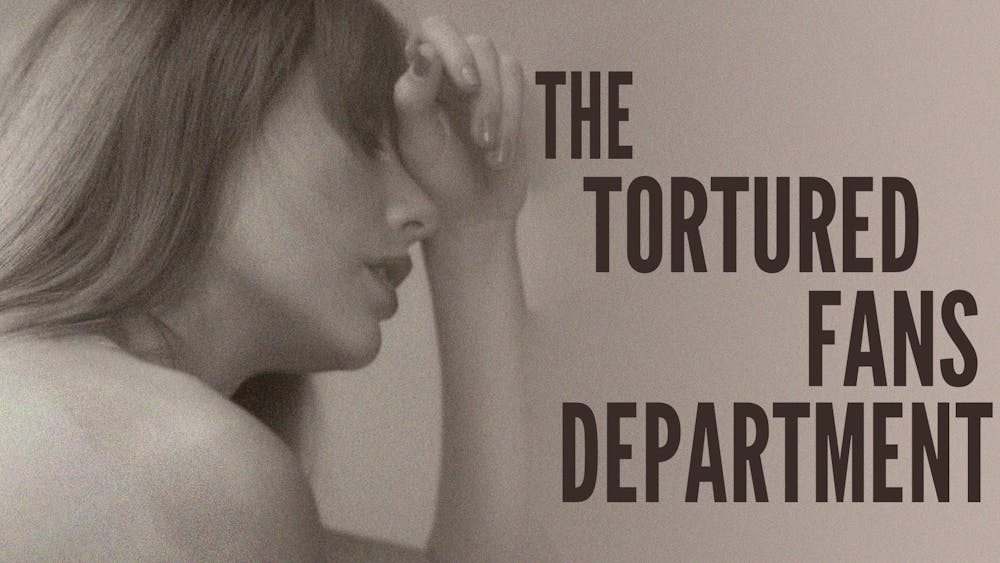Most art exhibitions tell a story of some kind, whether or not viewers are aware of it. Sometimes the organizers concentrate on the stylistic evolution of a single artist, while other times they draw connections between multiple artists working at a particular historical moment. DIGNITY, an exhibition of 52 photographs that recently opened at the Snite Museum of Art, tells a chilling story of human rights violations and extreme poverty.

The photos were taken by five different photojournalists who traveled to Mexico, India, Egypt, Nigeria and Macedonia, respectively, to capture scenes of daily life for a larger exhibition commissioned by Amnesty International France. The exhibition was adapted for an English audience and brought to Notre Dame thanks to the efforts of Julia Douthwaite, a professor in the Department of Romance Languages and Literatures.
One of the first images that visitors see upon entering the gallery is a large-scale photograph by Guillaume Herbaut of a man with his fingers interlocked and his hands behind his neck. He stands alone in a bare room, with his eyes downcast. Without reading the accompanying label, one might think that the man is fatigued from a hard day's labor, but he is actually demonstrating the position that Mexican soldiers forced him to maintain before beating him in 2003. According to the exhibition catalogue, the man was a human rights defender in the El Charco community, and was found dead in 2009.
Johann Rousselot's photographs of Eastern India focus on the forced evictions of indigenous populations in mineral-rich areas and the struggles of neighboring villages to maintain control of their lands. In one photograph, a woman wearing only a skirt and a shawl around her shoulders balances several pots and pans atop her head, making her body seem unusually elongated. Her stride is undeniably graceful, and the dirt path where she walks barefoot is clean and free of garbage, in stark contrast to many of the other photos in the exhibition. However, the caption for the photograph is ominous. The young woman is a resident of Kucheipadar, a village engaged in an ongoing battle over proposed mining projects that threaten the livelihoods of its inhabitants.

The lack of trash in Rousselot's photo is all the more blatant when compared to Philippe Brault's snapshot of the shantytown Ezbet El-Haggana, in Northern Egypt. High-voltage cables tower over a cluster of brick buildings situated so closely together that it appears as though one could walk from roof to roof — that is, if they were not covered with clothes, crates, chairs, tires and other debris. Despite the power lines that dominate the landscape, none of these homes have electricity, making it nearly impossible to find one's way through the slum at night.
Piles of rubbish are also a recurring theme in Michaël Zumstein's photographs of Lagos, Nigeria. The caption for one photograph — "Laundry on a clothesline at a home in Jakonde" — belies the scene of utter devastation and filth it depicts. The tiny hut is built on a raised platform, presumably to avoid traipsing through the dirty water and bags of trash floating below. Two women stand behind a blanket hung to dry, and one cannot help but wonder how they got there in the first place, since neither steps nor ladders are visible.
The final series of photographs in the exhibition are black-and-white portraits of the Roma, a minority group in Macedonia that faces discrimination and lower living standards than the rest of society. One of the most striking images is of a kneeling 17-year old boy named Subihan Nazirov, whose short-sleeve T-shirt ironically reads "RESPECT" in capital letters. Subihan was beaten for 24 hours straight by policemen because he was not carrying identification papers at a checkpoint. Perhaps this is how he acquired the scar above his left eyebrow.
All of the photographs speak of a life of incredible hardship. Christie McDonald, a professor of French and Comparative Literature at Harvard University who delivered a lecture about Jean-Jacques Rousseau's legacy prior to the opening reception of DIGNITY, acknowledged that we sometimes experience "a sense of helplessness" and "a desire to look away from harsh realities" when faced with testimonies like those in DIGNITY. She posed difficult questions, such as: "If human rights are self-evident, how is it that not everyone recognizes them?"
Although there is certainly no easy answer, DIGNITY helps raise awareness about the plight of the poor around the globe, and it tells the stories of people who have been silenced. Students and faculty alike should make a point to go see this tremendous exhibition, which will be on display through March 11.












